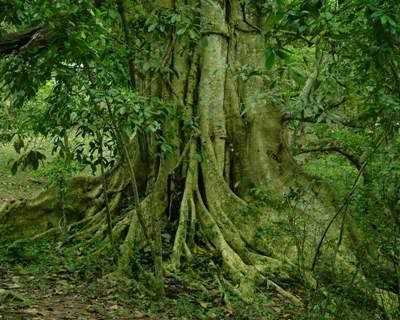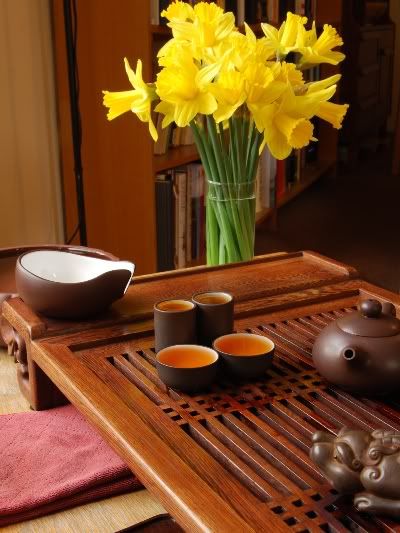A while back, we encountered the "blue/black label" version of the 1999 Menghai "Big Green Tree" [a.k.a. "Dalushu"], the acclaimed landmark tea in terms of dry storage.
It was big, not so green, and not at all treelike. Very many thanks to CB for kindly providing this opportunity to try out this alternative version for an invaluable comparison.
It was big, not so green, and not at all treelike. Very many thanks to CB for kindly providing this opportunity to try out this alternative version for an invaluable comparison.

We found the blue/black label version of this tea to be a bit of an anticlimax, finding it simply high and sweet flavour without any real guts.
I firmly believe that in tea, as with most other ventures, exposure and familiarity and experience count for a great deal. To that end, I try to drink a wide variety of teas that interest me - in that regard, the Big Green Tree is fascinating. However, I wouldn't want to own any of this and drink it for fun - while it's nice tea, it isn't exciting, and in the end that's the key factor in determining whether we should pursue it (especially when weighed against the truly eyewatering market rate for this tea, courtesy of its history). I'm content to drink a sample of this tea, expand my tastebuds a bit, then bid it farewell.
I firmly believe that in tea, as with most other ventures, exposure and familiarity and experience count for a great deal. To that end, I try to drink a wide variety of teas that interest me - in that regard, the Big Green Tree is fascinating. However, I wouldn't want to own any of this and drink it for fun - while it's nice tea, it isn't exciting, and in the end that's the key factor in determining whether we should pursue it (especially when weighed against the truly eyewatering market rate for this tea, courtesy of its history). I'm content to drink a sample of this tea, expand my tastebuds a bit, then bid it farewell.

It's my habit to turn out my entire sample to enable as many leaves as possible to be seen in the photograph - please don't use this quantity of tea for brewing. I had an e-mail on this subject recently! For the record, I used about half of the above for the session.
As always with dear old Menghai, the leaves are small and fragmented, with a darkly sweet aroma hanging about them. The colour is red-orange, indicating some proper aging.
As always with dear old Menghai, the leaves are small and fragmented, with a darkly sweet aroma hanging about them. The colour is red-orange, indicating some proper aging.

It's officially Spring - the daffodils are in full bloom.
The tea turns out to be a pleasant orange, a colour representing steps out of youth and into maturity. The aroma is very clean, and quite malty.
In the mouth, it was, being frank, rather a disappointment: clean flavours, decent potency and acidity prevail - and yet there's nothing really to keep the interest. It comes and goes without being too exciting, and I am left suspecting that I might be sorely disappointed if I had paid $400 for this tea.
There is no doubt that Menghai use decent leaves - the vibrant energy on the lips is considerable, and there is a long, long huigan.
"It's rather medicinal and simple, and doesn't seem as aged as the tuocha we had last night", says my dear wife, comparing it to the 1998 Menghai "Peacock". Succinct and accurate as ever, I can only agree.
The tea turns out to be a pleasant orange, a colour representing steps out of youth and into maturity. The aroma is very clean, and quite malty.
In the mouth, it was, being frank, rather a disappointment: clean flavours, decent potency and acidity prevail - and yet there's nothing really to keep the interest. It comes and goes without being too exciting, and I am left suspecting that I might be sorely disappointed if I had paid $400 for this tea.
There is no doubt that Menghai use decent leaves - the vibrant energy on the lips is considerable, and there is a long, long huigan.
"It's rather medicinal and simple, and doesn't seem as aged as the tuocha we had last night", says my dear wife, comparing it to the 1998 Menghai "Peacock". Succinct and accurate as ever, I can only agree.

This tea has aged slowly, and this could well be due to its purely dry storage. Sister teas from the same period (such as the 1998 Menghai Peacock, the 1998 Menghai 8582, the 1998 Menghai Dayi, the 1998 Menghai 7542, and the 1999 Menghai 7542) seem darker, richer, and exhibit considerably greater chaqi, as if they had an aging advantage - presumably due to wet storage occurring for at least part of their past (even though years of dry storage could have taken away the tell-tale dampness).
Independent of storage, I suspect that the real reason this tea seems one-dimensional is the ubiquitous use of tiny leaves, as shown above. It feels as if it needs something else, something additional, and I wonder if that could be some larger leaves.
As with the blue/black label version, I feel rather heretical saying such things about an industry benchmark tea, hence the "killing the Buddha" article before. However, I would be dishonest if I claimed this tea was anything but unexciting, so there we have it.
Thanks again to CB for the excellent continuing education in tea!
Independent of storage, I suspect that the real reason this tea seems one-dimensional is the ubiquitous use of tiny leaves, as shown above. It feels as if it needs something else, something additional, and I wonder if that could be some larger leaves.
As with the blue/black label version, I feel rather heretical saying such things about an industry benchmark tea, hence the "killing the Buddha" article before. However, I would be dishonest if I claimed this tea was anything but unexciting, so there we have it.
Thanks again to CB for the excellent continuing education in tea!

5 comments:
The essence of my comparison between the blue/black label version and this one is that the blue/black label exudes warm spiciness like incense/sandalwood, whereas the flavors of this standard issue from the same year are greener, less interesting, less mature. I applaud you for being honest with your maverick opinion, Hobbes, but I'm firmly in the camp with those who DO find something special about the blue/black label '99 Big Green Tree. If you have any of it left, might I suggest a side-by-side brewing of the two?
Oh, and I've been picking daffodils here too. And red maple buds. I can't call it ikebana, but those spikey kenzans are certainly useful little guys.
Dear Carla,
I can see spiciness in the blue/black, that's a good observation. For me, it just didn't seem as amazing as I thought - dare I say a touch underwhelming. It was clean, fresh, tasty... but perhaps (for me) it's value is more in what it represents (in terms of storage), rather than what's actually present in the cup.
Thanks again for a great comparison! I do indeed have a sample of both remaining, and so I shall do just as you suggest and brew them side-by-side.
Toodlepip,
Hobbes
P.s. It feels like the earth is waking up again! Summer is upon us! Mayday is imminent!
OK, I'll drop my two-cents on the table...
I've tried the blue/black on several occasions, and I actually like it. What I find in this tea is the promise of more to come. The current taste is not all that exciting -- spicy, yes, astringent yes, tobacco, yes, some sweetness, yes, overwhelming and mature, no. In the flavor department, it has plenty of cheaper neighbors in its age bracket. In my quirky SF-American opinion, the real strength and beauty of this tea is its long long long lasting huigan and throatiness. I can still remember my first taste of it... hmmm, its nice, yeah pretty good... whoa, what is that warm feeling going all the way to my belly and filling up my throat. Oh brother, thats nice -- kinda like the minutes after a good snort of brandy.
If that throatiness and after glow can remain, then the flavors will only improve over the years and turn this into a quite nice cake.
Unfortunately, I can't afford $400.00, so the discussion is purely hypothetical.
Dear Dave,
The depth of the chaqi and the effect on the body is something for me to look out for when I revisit them; thanks for the pointer. You had me at "brandy". :)
Thanks also for the notes - I always appreciate reading what you, and others, think of these same leaves as it gives me a more well-rounded picture of the teas. It's really important to me to see what I might be missing.
Toodlepip,
Hobbes
Post a Comment